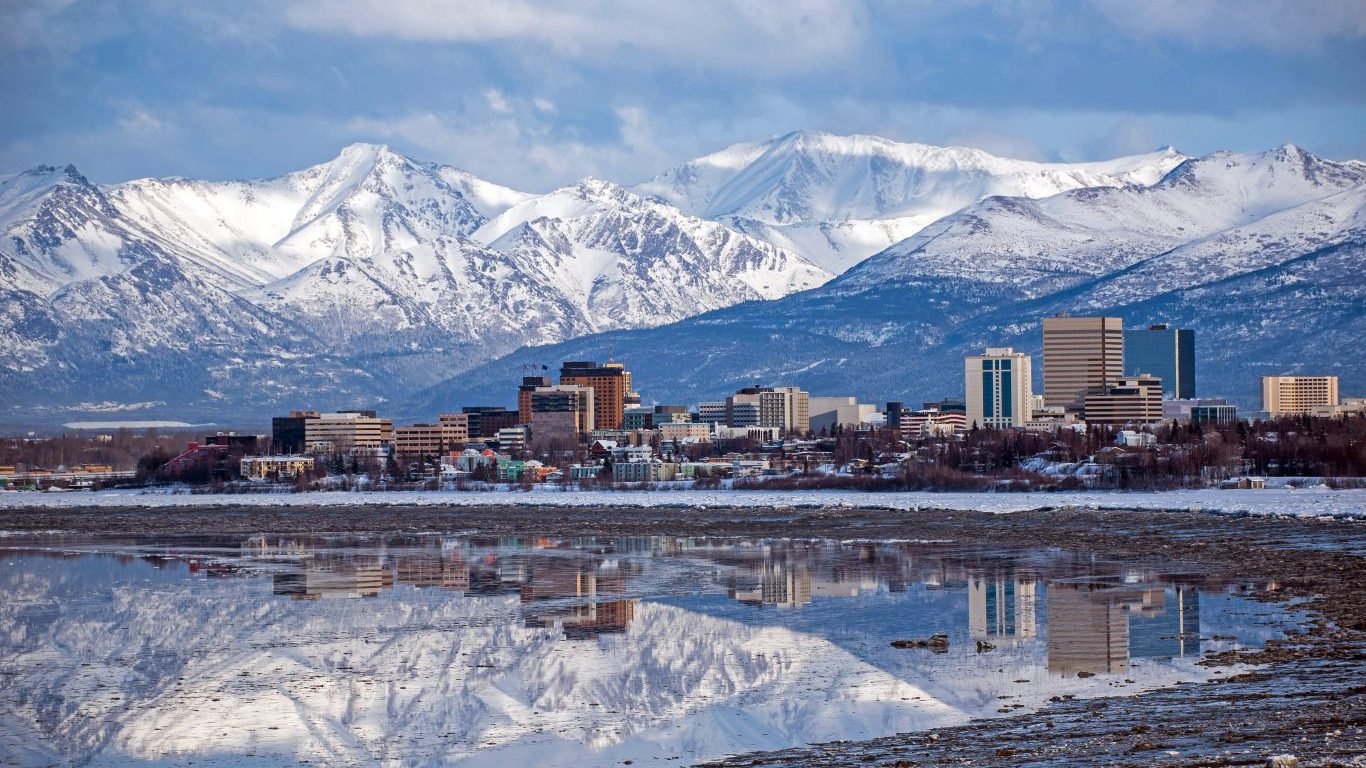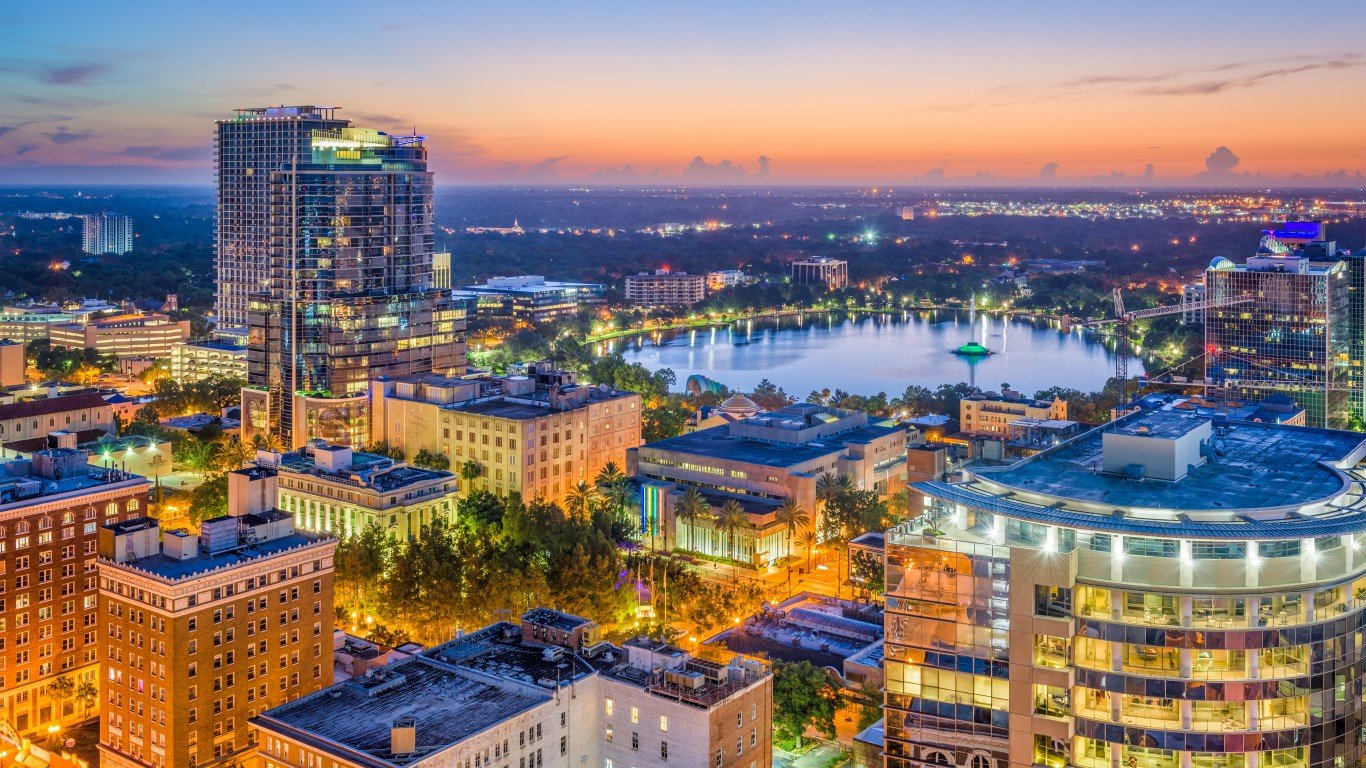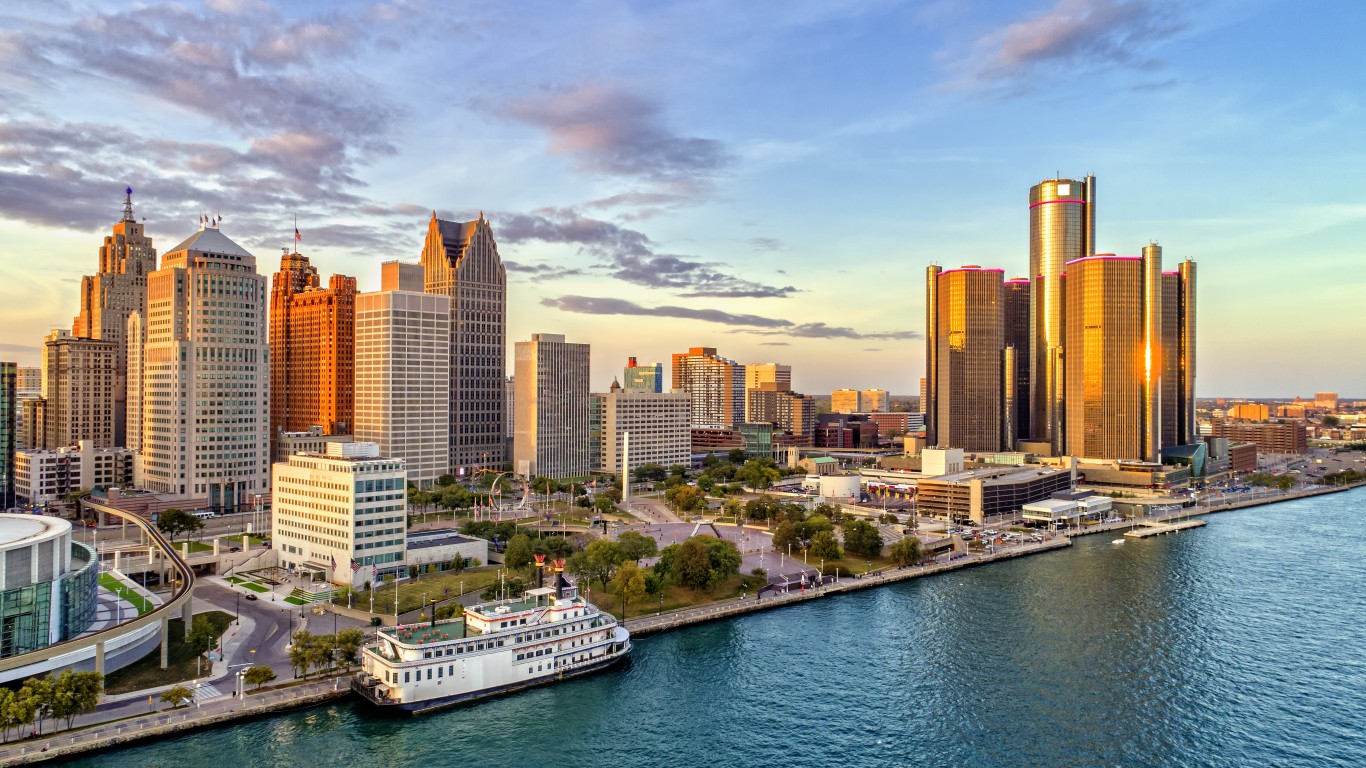

McDonald’s (NYSE: MCD) isn’t America’s largest fast food chain — there are only about 14,000 stores around the country, as opposed to more than 25,000 Subway outlets. It is, however, the largest hamburger chain by far — its nearest competitor, Burger King, has only about 7,500 stores — and the most iconic.
Using data collected from the McDonald’s website, 24/7 Wall St. has identified the number of McDonald’s locations in every state. The tally ranges from 25 in North Dakota to 1,295 in California. The concentration of McDonald’s restaurants also varies considerably.
Five of the 10 states with the highest concentrations of McDonald’s per 100,000 residents — West Virginia, Arkansas, Kentucky, Oklahoma, and Michigan — are also among the 10 states with the highest rates of obesity. However, there is virtually no research that establishes a causative link between the availability of Big Macs and Quarter Pounders — or any other fast food — and adverse health outcomes.
A 2011 study in The Journal of Rural Health, for instance, found an association (though not a causative link) between fast food outlets and negative health outcomes in metropolitan areas but not in a rural setting. In 2013, a National Heart, Lung, and Blood Institute’s CARDIA (Coronary Artery Risk Development in Young Adults) study found no association between BMI (body mass index) and density of fast food restaurants and convenience stores. In a systematic review of some 46 studies published between 2005 and 2015 on the relationship between a fast food environment and obesity rates in the United States and abroad by The Journal of Obesity and Weight Loss Therapy, the overwhelming majority found little or no consistent correlation between obesity and fast food.
On the other hand, a study published in 2015 by two researchers from the Geospatial Sciences Center of Excellence at South Dakota State University discovered that populations in urban settings served primarily by full-service restaurants and grocery stores had a lower obesity rate than those where fast food places and convenience stores predominated.
It is important to remember, though, that there are many other factors other than restaurant choices that may also contribute to obesity and other potentially diet-linked conditions such as cardiovascular disease and diabetes. Low income, high poverty rates, and relative unavailability of fresh fruits and vegetables also contribute to unhealthy lives.
Click here to see the states with the most McDonald’s.
Click here to see our detailed findings and methodology.

50. Rhode Island
> No. of McDonald’s: 2.9 per 100,000
> Adult obesity rate: 27.2% (17th lowest)
> Pct. consuming vegetables less than daily: 23.5% (20th highest)
> Median household income: $60,596 (18th highest)
[in-text-ad]

49. New Jersey
> No. of McDonald’s: 3.0 per 100,000
> Adult obesity rate: 25.9% (12th lowest)
> Pct. consuming vegetables less than daily: 22.1% (25th lowest)
> Median household income: $76,126 (3rd highest)

48. New York
> No. of McDonald’s: 3.1 per 100,000
> Adult obesity rate: 25.0% (8th lowest)
> Pct. consuming vegetables less than daily: 22.4% (23rd highest)
> Median household income: $62,909 (14th highest)

47. California
> No. of McDonald’s: 3.3 per 100,000
> Adult obesity rate: 22.7% (3rd lowest)
> Pct. consuming vegetables less than daily: 18.6% (9th lowest)
> Median household income: $67,739 (9th highest)
[in-text-ad-2]

46. North Dakota
> No. of McDonald’s: 3.3 per 100,000
> Adult obesity rate: 31.8% (12th highest)
> Pct. consuming vegetables less than daily: 27.5% (5th highest)
> Median household income: $60,656 (17th highest)

45. South Dakota
> No. of McDonald’s: 3.4 per 100,000
> Adult obesity rate: 30.6% (18th highest)
> Pct. consuming vegetables less than daily: 26.1% (9th highest)
> Median household income: $54,467 (22nd lowest)
[in-text-ad]

44. Massachusetts
> No. of McDonald’s: 3.5 per 100,000
> Adult obesity rate: 24.3% (4th lowest)
> Pct. consuming vegetables less than daily: 18.3% (7th lowest)
> Median household income: $75,297 (4th highest)

43. Washington
> No. of McDonald’s: 3.6 per 100,000
> Adult obesity rate: 27.0% (15th lowest)
> Pct. consuming vegetables less than daily: 16.9% (2nd lowest)
> Median household income: $67,106 (10th highest)

42. Idaho
> No. of McDonald’s: 3.6 per 100,000
> Adult obesity rate: 28.6% (24th lowest)
> Pct. consuming vegetables less than daily: 18.6% (9th lowest)
> Median household income: $51,807 (15th lowest)
[in-text-ad-2]

41. Utah
> No. of McDonald’s: 3.7 per 100,000
> Adult obesity rate: 25.3% (10th lowest)
> Pct. consuming vegetables less than daily: 20.0% (15th lowest)
> Median household income: $65,977 (11th highest)

40. Colorado
> No. of McDonald’s: 3.8 per 100,000
> Adult obesity rate: 20.5% (the lowest)
> Pct. consuming vegetables less than daily: 17.8% (5th lowest)
> Median household income: $65,685 (12th highest)
[in-text-ad]

39. Pennsylvania
> No. of McDonald’s: 3.9 per 100,000
> Adult obesity rate: 29.6% (22nd highest)
> Pct. consuming vegetables less than daily: 24.2% (18th highest)
> Median household income: $56,907 (23rd highest)

38. Delaware
> No. of McDonald’s: 4.0 per 100,000
> Adult obesity rate: 30.6% (18th highest)
> Pct. consuming vegetables less than daily: 20.7% (17th lowest)
> Median household income: $61,757 (15th highest)

37. Connecticut
> No. of McDonald’s: 4.0 per 100,000
> Adult obesity rate: 25.2% (9th lowest)
> Pct. consuming vegetables less than daily: 19.5% (14th lowest)
> Median household income: $73,433 (6th highest)
[in-text-ad-2]

36. Oregon
> No. of McDonald’s: 4.0 per 100,000
> Adult obesity rate: 27.2% (17th lowest)
> Pct. consuming vegetables less than daily: 16.5% (the lowest)
> Median household income: $57,532 (21st highest)

35. New Hampshire
> No. of McDonald’s: 4.0 per 100,000
> Adult obesity rate: 27.9% (19th lowest)
> Pct. consuming vegetables less than daily: 17.3% (3rd lowest)
> Median household income: $70,936 (7th highest)
[in-text-ad]

34. Minnesota
> No. of McDonald’s: 4.1 per 100,000
> Adult obesity rate: 27.3% (18th lowest)
> Pct. consuming vegetables less than daily: 22.4% (23rd highest)
> Median household income: $65,599 (13th highest)

33. Nebraska
> No. of McDonald’s: 4.1 per 100,000
> Adult obesity rate: 30.7% (17th highest)
> Pct. consuming vegetables less than daily: 24.7% (11th highest)
> Median household income: $56,927 (22nd highest)

32. Arizona
> No. of McDonald’s: 4.1 per 100,000
> Adult obesity rate: 26.7% (13th lowest)
> Pct. consuming vegetables less than daily: 20.5% (16th lowest)
> Median household income: $53,558 (20th lowest)
[in-text-ad-2]

31. Vermont
> No. of McDonald’s: 4.2 per 100,000
> Adult obesity rate: 24.7% (6th lowest)
> Pct. consuming vegetables less than daily: 17.6% (4th lowest)
> Median household income: $57,677 (20th highest)

30. Alaska
> No. of McDonald’s: 4.2 per 100,000
> Adult obesity rate: 29.4% (24th highest)
> Pct. consuming vegetables less than daily: 18.9% (10th lowest)
> Median household income: $76,440 (2nd highest)
[in-text-ad]

29. Texas
> No. of McDonald’s: 4.2 per 100,000
> Adult obesity rate: 28.4% (22nd lowest)
> Pct. consuming vegetables less than daily: 19.5% (14th lowest)
> Median household income: $56,565 (25th highest)

28. Florida
> No. of McDonald’s: 4.3 per 100,000
> Adult obesity rate: 25.9% (12th lowest)
> Pct. consuming vegetables less than daily: 21.3% (19th lowest)
> Median household income: $50,860 (13th lowest)

27. Georgia
> No. of McDonald’s: 4.4 per 100,000
> Adult obesity rate: 30.2% (21st highest)
> Pct. consuming vegetables less than daily: 24.7% (11th highest)
> Median household income: $53,559 (21st lowest)
[in-text-ad-2]

26. Montana
> No. of McDonald’s: 4.6 per 100,000
> Adult obesity rate: 25.0% (8th lowest)
> Pct. consuming vegetables less than daily: 19.3% (12th lowest)
> Median household income: $50,027 (11th lowest)

25. South Carolina
> No. of McDonald’s: 4.6 per 100,000
> Adult obesity rate: 32.0% (10th highest)
> Pct. consuming vegetables less than daily: 25.4% (10th highest)
> Median household income: $49,501 (10th lowest)
[in-text-ad]

24. Maine
> No. of McDonald’s: 4.6 per 100,000
> Adult obesity rate: 29.0% (25th lowest)
> Pct. consuming vegetables less than daily: 18.3% (7th lowest)
> Median household income: $53,079 (19th lowest)

23. Virginia
> No. of McDonald’s: 4.7 per 100,000
> Adult obesity rate: 28.3% (21st lowest)
> Pct. consuming vegetables less than daily: 21.7% (24th lowest)
> Median household income: $68,114 (8th highest)

22. Iowa
> No. of McDonald’s: 4.7 per 100,000
> Adult obesity rate: 31.8% (12th highest)
> Pct. consuming vegetables less than daily: 26.9% (6th highest)
> Median household income: $56,247 (25th lowest)
[in-text-ad-2]

21. North Carolina
> No. of McDonald’s: 4.8 per 100,000
> Adult obesity rate: 29.6% (22nd highest)
> Pct. consuming vegetables less than daily: 21.6% (23rd lowest)
> Median household income: $50,584 (12th lowest)

20. Maryland
> No. of McDonald’s: 4.8 per 100,000
> Adult obesity rate: 29.2% (25th highest)
> Pct. consuming vegetables less than daily: 21.3% (19th lowest)
> Median household income: $78,945 (the highest)
[in-text-ad]

19. Nevada
> No. of McDonald’s: 4.8 per 100,000
> Adult obesity rate: 26.8% (14th lowest)
> Pct. consuming vegetables less than daily: 19.2% (11th lowest)
> Median household income: $55,180 (24th lowest)

18. Mississippi
> No. of McDonald’s: 4.9 per 100,000
> Adult obesity rate: 35.3% (2nd highest)
> Pct. consuming vegetables less than daily: 31.2% (the highest)
> Median household income: $41,754 (the lowest)

17. Tennessee
> No. of McDonald’s: 4.9 per 100,000
> Adult obesity rate: 32.4% (8th highest)
> Pct. consuming vegetables less than daily: 22.6% (22nd highest)
> Median household income: $48,547 (8th lowest)
[in-text-ad-2]

16. New Mexico
> No. of McDonald’s: 5.0 per 100,000
> Adult obesity rate: 24.4% (5th lowest)
> Pct. consuming vegetables less than daily: 21.5% (22nd lowest)
> Median household income: $46,748 (7th lowest)

15. Wyoming
> No. of McDonald’s: 5.0 per 100,000
> Adult obesity rate: 28.5% (23rd lowest)
> Pct. consuming vegetables less than daily: 21.5% (22nd lowest)
> Median household income: $59,882 (19th highest)
[in-text-ad]

14. Alabama
> No. of McDonald’s: 5.0 per 100,000
> Adult obesity rate: 34.7% (3rd highest)
> Pct. consuming vegetables less than daily: 27.8% (4th highest)
> Median household income: $46,257 (5th lowest)

13. Kansas
> No. of McDonald’s: 5.1 per 100,000
> Adult obesity rate: 32.4% (8th highest)
> Pct. consuming vegetables less than daily: 22.3% (25th highest)
> Median household income: $54,935 (23rd lowest)

12. Louisiana
> No. of McDonald’s: 5.1 per 100,000
> Adult obesity rate: 34.7% (3rd highest)
> Pct. consuming vegetables less than daily: 31.0% (2nd highest)
> Median household income: $45,146 (4th lowest)
[in-text-ad-2]

11. Missouri
> No. of McDonald’s: 5.2 per 100,000
> Adult obesity rate: 31.8% (12th highest)
> Pct. consuming vegetables less than daily: 23.3% (21st highest)
> Median household income: $51,746 (14th lowest)

10. Wisconsin
> No. of McDonald’s: 5.2 per 100,000
> Adult obesity rate: 30.6% (18th highest)
> Pct. consuming vegetables less than daily: 24.0% (19th highest)
> Median household income: $56,811 (24th highest)
[in-text-ad]

9. Hawaii
> No. of McDonald’s: 5.2 per 100,000
> Adult obesity rate: 22.3% (2nd lowest)
> Pct. consuming vegetables less than daily: 21.4% (20th lowest)
> Median household income: $74,511 (5th highest)

8. Illinois
> No. of McDonald’s: 5.2 per 100,000
> Adult obesity rate: 28.0% (20th lowest)
> Pct. consuming vegetables less than daily: 24.3% (17th highest)
> Median household income: $60,960 (16th highest)

7. Oklahoma
> No. of McDonald’s: 5.2 per 100,000
> Adult obesity rate: 33.2% (7th highest)
> Pct. consuming vegetables less than daily: 24.5% (16th highest)
> Median household income: $49,176 (9th lowest)
[in-text-ad-2]

6. Indiana
> No. of McDonald’s: 5.2 per 100,000
> Adult obesity rate: 32.0% (10th highest)
> Pct. consuming vegetables less than daily: 26.7% (7th highest)
> Median household income: $52,314 (16th lowest)

5. Ohio
> No. of McDonald’s: 5.3 per 100,000
> Adult obesity rate: 31.6% (15th highest)
> Pct. consuming vegetables less than daily: 24.7% (11th highest)
> Median household income: $52,334 (17th lowest)
[in-text-ad]

4. Michigan
> No. of McDonald’s: 5.5 per 100,000
> Adult obesity rate: 31.3% (16th highest)
> Pct. consuming vegetables less than daily: 24.7% (11th highest)
> Median household income: $52,492 (18th lowest)

3. Kentucky
> No. of McDonald’s: 5.7 per 100,000
> Adult obesity rate: 33.7% (6th highest)
> Pct. consuming vegetables less than daily: 24.6% (15th highest)
> Median household income: $46,659 (6th lowest)

2. West Virginia
> No. of McDonald’s: 5.7 per 100,000
> Adult obesity rate: 35.5% (the highest)
> Pct. consuming vegetables less than daily: 26.5% (8th highest)
> Median household income: $43,385 (2nd lowest)
[in-text-ad-2]

1. Arkansas
> No. of McDonald’s: 5.8 per 100,000
> Adult obesity rate: 34.6% (5th highest)
> Pct. consuming vegetables less than daily: 28.1% (3rd highest)
> Median household income: $44,334 (3rd lowest)
Detailed findings
For its part, McDonald’s, while defending itself against accusations of targeting children and minority communities with its advertising, has seemingly acknowledged the public perception that its food has deleterious effects on communities. In 2012, the company agreed to provide nutritional information on its menus. In 2013, the chain announced that it was partnering with the Alliance for a Healthier Generation, founded by the American Heart Association and the Clinton Foundation to address childhood obesity and establish a system “that makes the healthy choice the easy choice.”
Among the commitments McDonald’s offered were to feature only water, milk, or juice on Happy Meal menu boards and child-directed advertising; to offer salad or a fruit or vegetable option as a substitute for fries in value meals; and to include a “fun” nutrition or well-being message in all external advertising aimed at children. It should be noted, however, that the chain plans to implement these initiatives in only 20 major markets, and it has given itself until 2020 to do so.
In compiling our data, we included not just the number of McDonald’s locations in each state, but also the number of locations per 100,000 residents — the concentration of McDonald’s stores ranges from 5.76 per 100,000 residents in first-place Arkansas to 2.93 in last-place Rhode Island. We also included obesity rates, vegetable consumption rates, and median income. In general, states with greater concentrations of McDonald’s tend to have lower median incomes and report worse health outcomes than those with smaller McDonald’s concentrations.
Interestingly, the number of McDonald’s around the country is shrinking. We found 13,948 of them this year, down from 15,828 in 2016. This may be due in part to a company decision to discourage so-called “mom and pop” franchisees in favor of larger operations. The chain has also experienced declining customer traffic in the United States in recent years.
Only five states have more McDonald’s today than they did two years ago, with the most significant growth, 13.8%, coming in Hawaii. In most states, however, the number of locations dropped considerably between 2016 and this year. Leading the downward trend is Rhode Island, where the number of McDonald’s restaurants fell from 44 in 2016 to only 31 this year, a nearly 30% decline. Close on the Ocean State’s heels was Ohio, where the decline was 25.2%, from 823 locations to 616.
Don’t worry, though: Those Golden Arches aren’t likely to go anywhere soon, and there are still 4.28 McDonald’s for every 100,000 Americans nationwide.
Methodology
To determine the states with the most McDonald’s, 24/7 Wall St. calculated the number of McDonald’s locations per 100,000 residents with data from the McDonald’s online restaurant locator. Data on population came from the U.S. Census Bureau and is for 2017. Data on median household income came from the Census Bureau’s 2016 American Community Survey. Obesity data came from County Health Rankings & Roadmaps, a collaboration between the Robert Wood Johnson Foundation and the University of Wisconsin Population Health Institute. Data on the percentage of adults who consume fruit and vegetables less than once a day came from the Centers for Disease Control and Prevention and is for 2015. All data is for the most recent period available.
Sponsored: Find a Qualified Financial Advisor
Finding a qualified financial advisor doesn’t have to be hard. SmartAsset’s free tool matches you with up to 3 fiduciary financial advisors in your area in 5 minutes. Each advisor has been vetted by SmartAsset and is held to a fiduciary standard to act in your best interests. If you’re ready to be matched with local advisors that can help you achieve your financial goals, get started now.
Thank you for reading! Have some feedback for us?
Contact the 24/7 Wall St. editorial team.
 24/7 Wall St.
24/7 Wall St. 24/7 Wall St.
24/7 Wall St. 24/7 Wall St.
24/7 Wall St. 24/7 Wall St.
24/7 Wall St.
